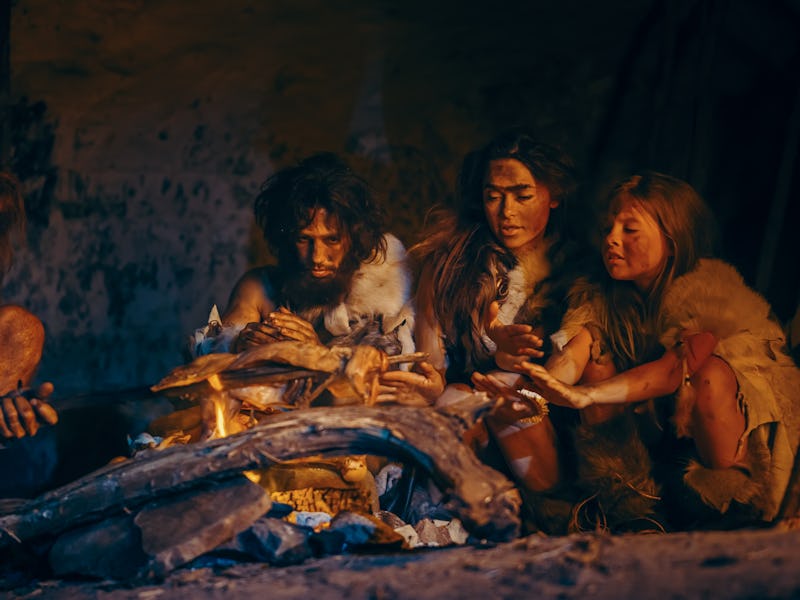Study reveals what Neanderthal babies might've looked like
A coming of age story.

At-home DNA tests reveal how much of your DNA is Neanderthal, but scientists still don't know what it means for modern humans to have this DNA in the first place.
One of the key questions they have is: To what extent are we physically different to our ancient hominid peers?
Using the fossil record, scientists have pieced together a picture of adult Neanderthals, revealing them to be stockier and more "barrel-chested" than modern humans. But a lack of fossil evidence for younger Neanderthals meant researchers knew little about when these features actually emerged in the species' development. Were they born with this strange physiology, or did they develop them through childhood and adolescence?
A new study published Wednesday in the journal Science Advances sheds light on this genetic mystery. Using computing modeling, researchers virtually reconstructed the ribcages of four Neanderthal children, all under the age of five.
What they found has implications for how we visualize Neanderthals, but also how we see our own species' bodies, too, the authors say.
See also: Neanderthal genetics study reveals missing link in human history
"[D]espite being the best-known extinct human species, there are only a few studies on the Neanderthal postnatal ontogeny [or, development] due to the [scarcity] of well-preserved subadult fossil remains," explain the researchers in the study. "So far, only basic descriptions and inventories of fossil ribs and vertebrae have been available and artistic license was used when ribcage reconstructions of subadults were made."
To get a more accurate idea of what young Neanderthals' bodies would have actually looked like, the research team focused on four partial fossil Neanderthals that ranged in age from only a few months old to almost four years old.
The researchers took 3D scans of the fossils' anatomy. From there, they used 3D and statistical modeling to reconstruct each fossil's rib cage, and then compared their development to that of a modern human child.
By virtually reconstructing the rib cages of ancient Neanderthals, researchers are learning more about us as well.
Family secrets — When comparing the development of modern human children to that of these young Neanderthals, the researchers discovered some key differences.
Regardless of their age, the Neanderthal children appeared to have consistently shorter spines and deeper rib cages than those of modern human children. Because these traits appeared consistent regardless of when the Neanderthals died, the researchers hypothesize the traits were genetic and present at birth.
"[This] is crucial because it indicates that slight modifications during development at different rib levels would cause different ribcage morphologies. This could have evolutionary implications for understanding the adult thorax not only in our own species but also in other hominins such as Neanderthals," they say.
A stocky build would likely have been advantageous for adult Neanderthals, as they were larger than other human species at that time and required more energy — and oxygen — to live, the researchers note.
Despite these clear differences, the researchers say it's not quite accurate to describe Neanderthals as barrel-chested and their contemporaries, Homo erectus, as "normal."
"[S]ome 20th-century anthropologists [refer] to adult Neanderthals as 'barrel-chested.' However, this is confusing because the ribcages of Homo erectus from Nariokotome and the [modern human] ribcage have also been called 'barrel-shaped," write the authors.
Instead, both these ancient hominids and modern humans all have "barrel chests," but in slightly different ways. A Neanderthal's ribs could be described as "short and deep," while ours might be called a "tall and flattened" barrel. Ultimately, the similarities could shed light on our own genetics, the researchers say.
These different torsos may be useful when distinguishing ancient hominins from other primates, but in the murky gene pool of ancient humans themselves, the differences aren't quite so stark.
Abstract: Ontogenetic studies provide clues for understanding important paleobiological aspects of extinct species. When compared to that of modern humans, the adult Neanderthal thorax was shorter, deeper, and wider. This is related to the wide Neanderthal body and is consistent with their hypothetical large requirements for energy and oxygen. Whether these differences were already established at birth or appeared later during development is unknown. To delve into this question, we use virtual reconstruction tools and geometric morphometrics to recover the 3D morphology of the ribcages of four Neanderthal individuals from birth to around 3 years old: Mezmaiskaya 1, Le Moustier 2, Dederiyeh 1, and Roc de Marsal. Our results indicate that the comparatively deep and short ribcage of the Neanderthals was already present at birth, as were other skeletal species-specific traits. This morphology possibly represents the plesiomorphic condition shared with Homo erectus, and it is likely linked to large energetic requirements.